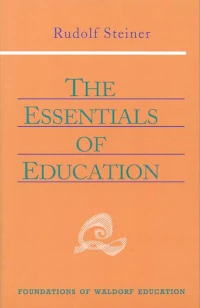The Essentials of EducationI
GA 308

The lectures that Rudolf Steiner gave in April, 1924, now freshly revised and republished as The Essentials of Education and The Roots of Education, represent a remarkable synthesis of Waldorf education as a practical manifestation of anthroposophy. This can be experienced through the flowing content of the lectures themselves and their place in the context of Steiner’s work.
First in Stuttgart and then in Bern, Steiner delivered these lectures just eleven months before his death in March, 1925 and five years after the founding of the first Waldorf school in 1919. He had trained the teachers of the first Waldorf school and had the opportunity to have regular conversations with them in faculty meetings over several years.1 Out of the practical experiences of working with the first schools, Steiner was in a position in April, 1924 to share the distilled essence, the most urgent themes arising from his educational work.
| Lecture One | April 8, 1924 | |
| Necessity for knowledge of the whole human being for a genuine education. The relationship between teacher and child is far-reaching. Before seven, the child is a “sense organ,” and the body, soul, and spirit exist as a unity. The effects of the teacher’s temperament on the child. The teacher’s task during the three stages of childhood. | ||
| Lecture Two | April 9, 1924 | |
| The demand for proof and the appropriate proof in spiritual matters. The descent of spirit into the body during the first seven years. The small child’s natural religious devotion and the corresponding religious element needed in the teacher. After seven the child needs the teacher to be an artist. Humanity’s development of materialism. The importance of imagery in teaching. Learning letters. Extremes in education. | ||
| Lecture Three | April 10 a.m., 1924 | |
| Ancient humankind could “read” nature and human nature intuitively; modern science can “spell” but not “read.” Learning to “read” children. Digestion before and after the change of teeth. Relationship between breath and heartbeat from seven to fourteen and how music harmonizes them. The etheric body and sculpting. The astral body and music. The I-being and speech. Eurythmy, music, and speech. | ||
| Lecture Four | April 10 p.m., 1924 | |
| Writing before reading. Understanding Sun and Moon forces in plants. Learning through images after the tenth year. Understanding music and the images of bull, lion, and eagle harmonized in the human being. The human being as a symphony of individual tones that sound in various animals. Images given between seven and fourteen are understood intellectually after puberty. | ||
| Lecture Five | April 11, 1924 | |
| Education must be lived. The small child imitates the good, beautiful, and wise. During the first stage a child is naturally religious. In the second stage the religious becomes soul quality through images and respect for authority. Logic after puberty. Kant, Schiller, and Goethe on duty. The effects in old age of reverence in a child. The need to understand the human being in body, soul, and spirit. | ||

